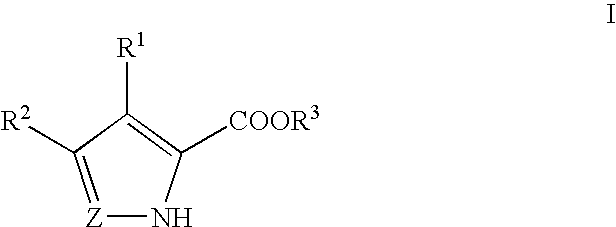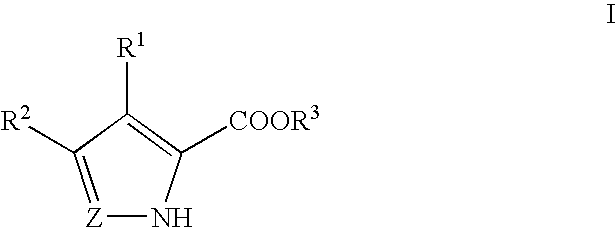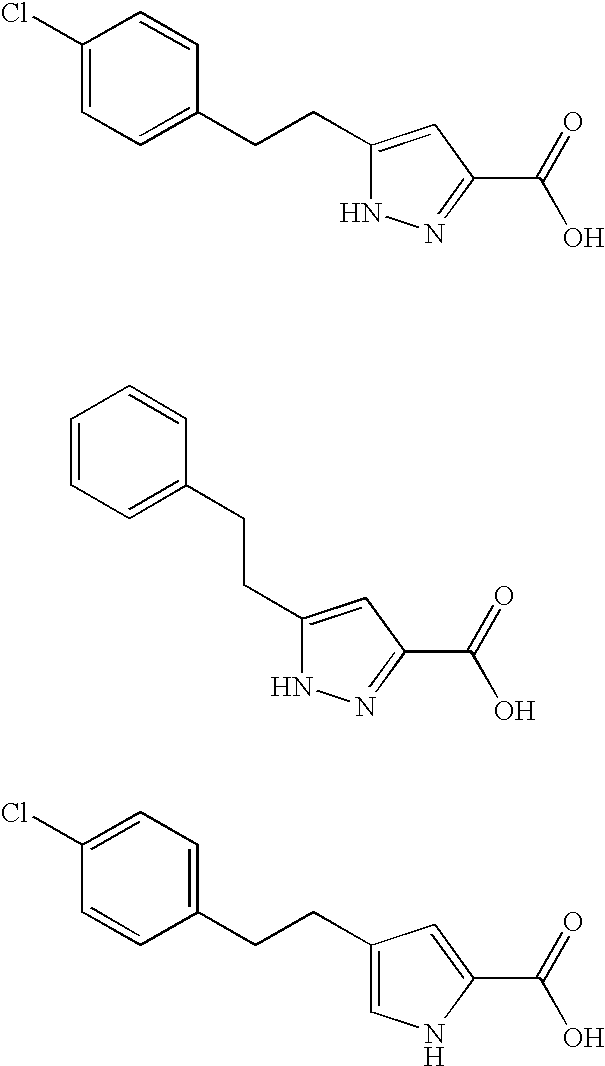Pyrrole and pyrazole DAAO inhibitors
a technology of pyrrole and pyrazole, which is applied in the direction of biocide, muscular disorder, drug composition, etc., can solve the problems of not being able to make any significant difference, lack of a standard nootropic drug for such treatment, and disorder accompanied by high morbidity and mortality rates, so as to inhibit daao activity, improve symptoms, and inhibit daao activity
- Summary
- Abstract
- Description
- Claims
- Application Information
AI Technical Summary
Benefits of technology
Problems solved by technology
Method used
Image
Examples
example 1
Synthesis of 6,6-Dimethyl-1,4,5,6-tetrahydrocyclopentapyrazole-3-carboxylic acid (3)
[0116]
Synthesis of (3,3-Dimethyl-2-oxocyclopentl)-oxoacetic acid ethyl ester (1)
[0117] Sodium hydride (0.428 g, 17.8 mmol) was added slowly to a NaCl ice bath containing EtOH (5.4 mL, 3.3 M) stirring under N2. 2,2-dimethylcyclopentanone (2.00 g, 17.83 mmol) and diethyloxalate (2.42 mL, 17.8 mmol) were mixed together, and then added to the chilled NaOEt solution. After stirring for 15 minutes, the reaction was warmed to room temperature and stirred for 6 hours, at which point the reaction was judged complete by TLC. The reaction was quenched at 0° C. with 1N HCl and extracted 2× with CH2Cl2. The combined organics were washed with H2O, dried with Na2SO4, filtered, and concentrated to yield 3.4084 g (90.0%) of crude 2 that was sufficiently pure by NMR to go on to the next step without further purification. Note: NaOEt purchased from Aldrich may be substituted for the NaOEt synthesized in situ. 1H (CDC...
example 2
Synthesis of 3-methyl-1,4,5,6-tetrahydrocyclopentapyrazole-3-carboxylic acid (6)
[0120]
Synthesis of (3-methyl-2-oxocyclopentyl)-oxoacetic acid ethyl ester (4)
[0121] 2-methylcyclopentanone (1.0058 g, 10.2 mmol) and diethyloxalate (1.38 mL, 10.2 mmol) were mixed together, and then added to a solution of NaOEt (˜3 M, 3.4 mL) stirring in an ice bath under N2. After stirring for 15 minutes, the reaction was warmed to room temperature and stirred overnight. The reaction was quenched at 0° C. with 1N HCl and extracted 2× with CH2Cl2. The combined organics were washed with H2O, dried with Na2SO4, filtered, and concentrated to yield crude 4. The crude material was purified with 98:2 to 96:4 Hexanes:EtOAc to obtain 0.5635 g (27.7%) of 4. 1H (CDCl3, 400 MHz): δ 4.29 (2H, q, J=7.1 Hz), 2.96 (1H, ddd, J=17.6, 8.1, 1.5 Hz), 2.69 (1H, ddd, J=17.6, 9.5, 8.1 Hz), 2.57-2.47 (1H, m), 2.24 (1H, dtd, J=12.5, 8.3, 2.4 Hz), 1.49 (1H, dtd, J=12.5, 10.3, 8.4 Hz), 1.34 (3H, t, J=7.1 Hz), 1.13 (3H, d, J=7.0 ...
example 3
Synthesis of 4-methyl-1,4,5,6-tetrahydrocyclopentapyrazole-3-carboxylic acid (11) and 5-methyl-1,4,5,6-tetrahydrocyclopentapyrazole-3-carboxylic acid (12)
[0124]
Synthesis of (2-methyl-5-oxocyclopentyl)-oxoacetic acid ethyl ester (7) and (4-methyl-2-oxocyclopentyl)-oxoacetic acid ethyl ester (8)
[0125] Sodium hydride (0.122 g, 5.09 mmol) was added slowly to a NaCl ice bath containing EtOH (1.54 mL, 3.3 M) stirring under N2. 3-methylcyclopentanone (0.500 g, 5.09 mmol) and diethyloxalate (0.69 mL, 5.09 mmol) were mixed together, and then added to the chilled NaOEt solution. After stirring for 15 minutes, the reaction was warmed to room temperature and stirred for 6 hours, at which point the reaction was judged complete by TLC. The reaction was quenched at 0° C. with 1N HCl and extracted 2× with CH2Cl2. The combined organics were washed with H2O, dried with Na2SO4, filtered, and concentrated to yield 0.5591 g (55.4%) of crude 7 and 8 as an approximately 1:1.1 mixture. Although condition...
PUM
| Property | Measurement | Unit |
|---|---|---|
| temperature | aaaaa | aaaaa |
| temperature | aaaaa | aaaaa |
| HPLC retention time | aaaaa | aaaaa |
Abstract
Description
Claims
Application Information
 Login to View More
Login to View More - R&D
- Intellectual Property
- Life Sciences
- Materials
- Tech Scout
- Unparalleled Data Quality
- Higher Quality Content
- 60% Fewer Hallucinations
Browse by: Latest US Patents, China's latest patents, Technical Efficacy Thesaurus, Application Domain, Technology Topic, Popular Technical Reports.
© 2025 PatSnap. All rights reserved.Legal|Privacy policy|Modern Slavery Act Transparency Statement|Sitemap|About US| Contact US: help@patsnap.com



